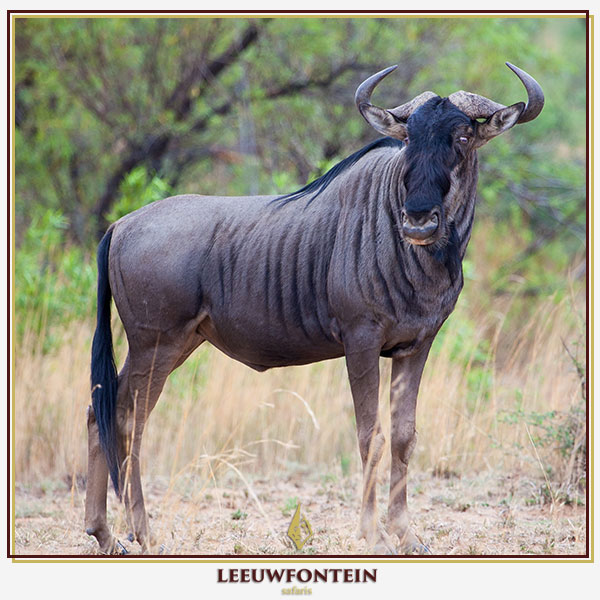The blue wildebeest, also known as the brindled gnu (Connochaetes taurinus), is a prominent antelope species indigenous to southern and eastern Africa. Renowned for its robust build and distinctive appearance, the blue wildebeest offers hunters in South Africa a unique and challenging pursuit. This comprehensive profile delves into the physical characteristics, trophy considerations, behavior, habitat, hunting strategies, recommended equipment, shot placement, and ethical hunting practices associated with the blue wildebeest.?
The blue wildebeest exhibits a sturdy, ox-like physique with a characteristic sloping back and pronounced shoulders. Adult males typically weigh between 250 to 290 kilograms (550 to 640 pounds), while females range from 180 to 210 kilograms (400 to 460 pounds). Both sexes stand approximately 1.15 to 1.4 meters (45 to 55 inches) at the shoulder. Their body length varies from 1.7 to 2.4 meters (67 to 94 inches), complemented by a tail measuring about 60 to 100 centimeters (24 to 39 inches).
The blue wildebeest's coat is a dark silver-gray, marked with distinctive dark vertical stripes on the forequarters. A prominent black mane runs from the top of the head down the neck, and a beard of dark hair adorns the throat. Both males and females possess horns that curve outward and downward before hooking upward at the tips. Mature males typically have thicker and more robust horns, measuring between 68 to 83 centimeters (27 to 33 inches) in length.
For hunters seeking to document their blue wildebeest trophies, horn length, mass, and symmetry are critical factors. The Safari Club International (SCI) recognizes a minimum trophy qualification total score of 70 inches, combining horn length and base circumference. Exceptional specimens may exceed this benchmark, reflecting the animal's maturity and genetic quality. Meticulous measurement and documentation not only honor the hunt but also contribute to responsible game management practices.
Blue wildebeest are predominantly grazers, favoring short grasses in open savannas and grasslands. They are social animals, typically forming herds ranging from 15 to 35 individuals, although larger aggregations can occur during migration or in areas with abundant resources. Mature bulls often establish and defend territories, especially during the breeding season, known as the rut, which peaks between March and May.
In South Africa, blue wildebeest inhabit various regions, including the Eastern Cape and Free State provinces. They thrive in areas that offer a mosaic of open plains, woodlands, and access to water sources, as they require daily water intake. Their keen senses and herd vigilance make them challenging quarry, as they are quick to detect and flee from potential threats.
Pursuing blue wildebeest necessitates a combination of patience, skill, and strategic planning. Given their preference for open terrains and acute senses, hunters must employ tactics that minimize detection:
Stalking and Spotting: Focus on known foraging areas, particularly during the early morning or late afternoon. Patience is key; move slowly and remain low to minimize your profile. The play of light and shadow during these times can both mask your movements and create visual challenges, so a cautious, deliberate approach is crucial.
Ambush Hunting: Identify frequented grazing areas or waterholes and set up a concealed position. Early mornings and late afternoons are optimal times, aligning with the blue wildebeest's active periods.?
Tracking:Learning to identify and interpret subtle signs of blue wildebeest activity, such as hoof prints, droppings, or disturbed vegetation, is invaluable. Once a group or individual is located, plan your approach carefully, keeping in mind wind direction and noise minimization to avoid startling your quarry.
Given the open environments blue wildebeest inhabit, shots may need to be taken at longer ranges, necessitating proficiency in marksmanship.
Selecting appropriate equipment is vital for an ethical and successful blue wildebeest hunt:?
Caliber Recommendations:
Medium to large calibers such as the .30-06 Springfield, .300 Winchester Magnum, or 7mm Remington Magnum are well-suited for blue wildebeest hunting, offering a balance between manageable recoil and sufficient stopping power.
Rifle Considerations:
A bolt-action rifle equipped with a quality scope (3-9x magnification) is recommended to accommodate the potential for longer-distance shots inherent in open plains hunting.
Ammunition:
Premium-grade ammunition with controlled-expansion bullets, such as Nosler Partition or Barnes X, ensures reliable performance and effective energy transfer upon impact.
Ensuring familiarity with your chosen firearm and consistent practice is essential for accurate shot placement.
Ethical hunting mandates precise shot placement to ensure a swift and humane kill:
Vital Areas:
Aim for the heart-lung area, located just behind the shoulder, to maximize the likelihood of a quick expiration.
Shot Angle:
Broadside shots are ideal, providing clear access to vital organs. Exercise caution with quartering or frontal shots due to the increased risk of wounding.
Follow-up Shots:
Always be prepared for a follow-up shot if the initial attempt does not achieve the desired outcome.
Adherence to local regulations, respect for wildlife, and a commitment to conservation are integral components of ethical hunting.
The blue wildebeest (Connochaetes taurinus) offers one of the most exciting and rewarding hunting experiences in South Africa. Its sharp senses, unpredictable movements, and social behavior make it a challenging quarry that requires patience, skill, and ethical hunting practices.
With the right approach—including a suitable rifle, well-placed shots, and a strategic hunting plan—hunters can successfully pursue this formidable plains game species while contributing to sustainable wildlife management efforts.
Whether you are tracking a solitary bull or carefully approaching a wary herd, the pursuit of the blue wildebeest is a thrilling test of hunting prowess, strategy, and respect for nature.

| # | NAME | |
| 1. | Species List | |